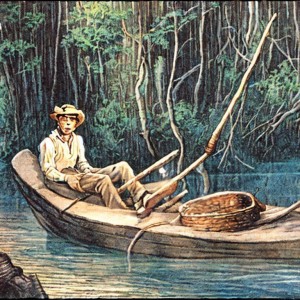“The Adventures of Huckleberry Finn” is a novel by American writer Mark Twain, the sequel to The Adventures of Tom Sawyer, published in 1876. Twain worked on the work for about ten years. “The Adventures of Huckleberry Finn” was first published in 1884 in the United Kingdom. In 1885, the Concord Public Library (Massachusetts) called the novel “garbage suitable only for slums” and forbade it. Twain reacted with irony, writing to his publisher that, thanks to the decision of the library, “another 25 thousand copies of the book” could be sold.
In the mid-20th century, the National Association for the Advancement of Colored People discovered racist parties in the novel and demanded that “The Adventures of Huckleberry Finn” be removed from New York High Schools. Subsequently, the book more than once had problems due to allegedly racist statements.
Features of the language of the work
The narrative is on behalf of Huckleberry Finn, a poorly educated kid who speaks a southwestern dialect. The novel is written in colorful folk language, Negro dialectisms, colloquial expressions, slang are used. Mark Twain decided on a bold update of the literary language. Not least because of this, his “The Adventures of Huckleberry Finn” played a crucial role in the history of American literature. No wonder Ernest Hemingway wrote about this novel: “All American literature came out of one book – Huckleberry Finn by Mark Twain.”
The main characters of the novel
The main character of the book, Mark Twain made Huckleberry Finn – a tramp boy belonging to the lower layers of the population. He escapes from the city of St. Petersburg from the widow of Douglas, who sheltered him. He dislikes a life in which a huge number of rules must be observed. Then Huck escapes from his drunken father, who is often cruel to a child. Meeting the runaway black man Jim, he goes on a journey with him, during which he experiences many adventures. On the pages of the novel, the struggle of conflicting trends in Huck’s soul is revealed. On the one hand, the boy is not alien to the traditional attitude to slavery in the South of the USA. On the other hand, in the name of goodness, friendship with the black man Jim, he is ready to sacrifice many things. Huckleberry even agrees to burn in hell – these are not empty words for him. Huck sincerely believes in the existence of the underworld.
The second positive character of the novel is the black man Jim, who escaped from his mistress Miss Watson, because she wanted to sell it. Jim appears to readers as a man with a big heart and a noble soul. He is devoted to Huck, but not as a master, but as a friend. Jim dreams of freedom, but is ready to sacrifice his dream for the sake of Huck and his friend Tom Sawyer. When Tom is injured in the leg, Jim decides to wait for the doctor, risking falling into slavery again.
Huck and Jim have one very important thing in common. Both of them differ in their natural attitude. These characters are depicted on the pages of the book as they were created by nature.
Composition
Mark Twain leads Huckleberry Finn through a series of tests that are increasing, that is, as the events of the book unfold, the laws of civilization are increasingly invading the natural life of Huck and the black man Jim.
The first part is the period of idyll. Huck and Jim sail on a raft. Their life in the bosom of nature far from civilization can be called ideal. In the second part, Huckleberry is forced to protect the black man Jim from a clash with civilization. Any respectable American becomes dangerous, but the greatest danger is a pair of scammers – the king and the duke. This part clearly shows the struggle in the soul of Huck, which was mentioned above. The turning point is the episode when Huckleberry and Jim lost each other in the fog. After the danger has passed, the boy decides to play a gullible black man. Jim takes touching care of his friend: “And when Jim woke up and saw Huck safe and sound, hot tears flowed from his eyes, and Jim wanted to kiss your legs, so Jim was happy and glad. And you, Huck, were only thinking about how to mock poor old Jim, fool him, deceive him! ” Heku becomes ashamed, and he finds the strength to ask Jim for forgiveness.
In the third part of the book, Huckleberry’s moral position is clearly indicated. He is shown by a brave boy who rescues the black man Jim with particular resourcefulness. At the same time, Huck does not shy away from using any methods to achieve the goal. In its controversial nature, humanity is combined with practicality. Huckleberry is kind by nature, he pities even the cruel bandits who remained on the sinking ship. Despite this, the good people for Huck are eccentrics, which are used by all sorts of scammers with pleasure.
Key topics
Mark Twain opposed racism, as reflected in the pages of The Adventures of Huckleberry Finn. The lines from Twain’s letter dated 1901, that is, written many years after the release of the novel, are noteworthy: “One of my theories is that people’s hearts are the same all over the world, regardless of skin color.” In The Adventures of Huckleberry Finn, Mark Twain advocates for the rights of both Huck and black Jim. In addition, the writer clearly admires their kind hearts.
Using various artistic means, combining tragic and comic episodes, Twain proves that blacks are just like white people. They are able to love their families just as much, just as faithfully be friends, as well as not to lose hope for the best. Naturally, among blacks, as well as among whites, bad people are found. A vivid example is a black man who deceived other blacks by allegedly opening a bank.
Another major theme in the novel is the theme of freedom. Jim dreams of freedom, he aspires to it by all means. Indomitable freedom love is inherent in the character of Huckleberry Finn. In the novel, Mark Twain defends the right to freedom for all – regardless of social status and skin color.

